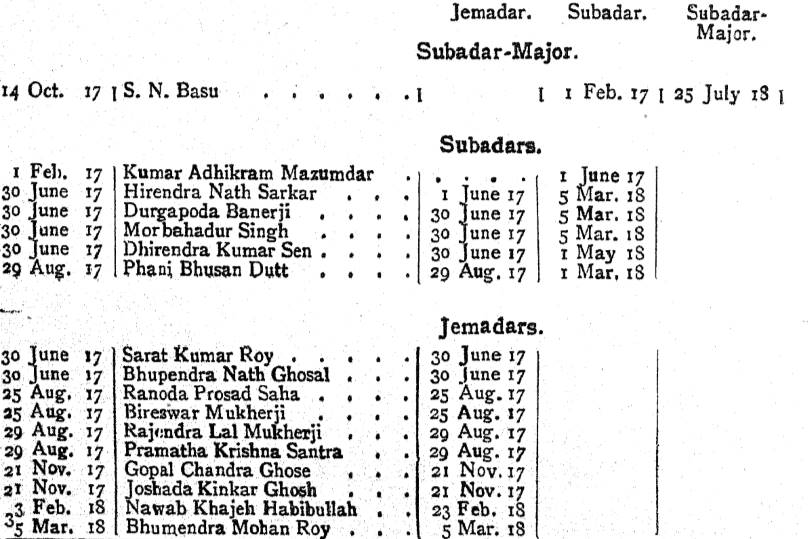This article is about the 49th Bengal Infantry and aims to help you research the Regiment and soldiers who served with it during the First World War. I have also have created a series of guides to help you research soldiers who served in the Indian Army during the First World War:
The 49th Bengal Infantry in the First World War
Lineage: Formed at Karachi on 1 July 1917 as the 49th Bengal Infantry but later redesignated as the 49th Bengalis. The Regiment was disbanded on 30 August 1920.
Class Composition of Battalion in 1919: Bengalis.
The 49th Bengalis was one of the most unusual Indian units to be formed during the First World War and the Regiment makes an excellent case study of the martial races theory. The Regiment was borne by the desire of Bengalis to contribute to the war effort and a Double Company of Bengalis was recruited in 1916. These early recruits formed the basis of the Regiment which was formed at Karachi on 1 July 1917. The extract below was taken from the July 1918 Indian Army List and recorded the Indian officers serving with the Regiment.

The discipline, tone and appearance of all ranks has improved of late, but is still far from satisfactory. The men can turn out well but do not do so as they are by nature of dirty, filthy habits. Morally and physically they are without much stamina and generally lack all sense of responsibility, decency or shame. Reliable Bengali Indian Officers and Non-Commissioned Officers seem quite unprocurable, and without these satisfactory results can hardly be expected.
Lieutenant-General C. A. Anderson also reported:
I saw this depot on 21st January 1919. In spite of all efforts made to turn them into soldiers the material is physically so unpromising and mentally so unsuited to become soldiers that I do not think it could ever be brought to the point of having any military value as fighting material.
Confidential review reports on Indian Army units, depots, British officers, etc. for 1918-1919 IOR/L/MIL/7/17030
The 49th Bengalis arrived at Basra, Mesopotamia (Iraq) in July and August 1917. The Regiment would have an uneventful war serving on the Lines of Communication for nearly three years. For the exact location of the Regiment and its activities, there are two war diaries which can be downloaded. The 49th Bengalis returned to India in 1920 and was disbanded on 30 August 1920.
War Diaries of the 49th Bengalis
There are two war diaries for the 49th Bengalis and both have been digitized by the National Archives. To download the war diaries for a small fee click on the blue links below which will take you to the National Archives’ website. I have transcribed some extracts at the bottom of the page.
- Date: 01 July 1917 – 30 April 1918
- Tigris Defences and Communications, Aziziyeh
- Reference: WO 95/5020/5
- Notes: The first half of the war diary is typed and there are frequent mentions of British and Indian officers and other ranks (with regimental numbers). The 49th Bengalis were serving on the lines of communication so there is very little of interest in the diary. Many daily entries consist of nothing more than notations of deaths or invaliding due to disease.
- Date: 01 May 1918 – 30 April 1920
- Lines of Communication, Mesopotamia
- Reference: WO 95/5247/5
- Date: 01 May 1918 – 30 April 1920
- Notes: Like most units serving on the lines of communication, very little happened. Between May 1918 and March 1919, the war diary is typed. British and Indian officers are mentioned throughout and British Non-commissioned officers who are serving with the 49th Bengalis are frequently mentioned as they come and go.
Further Sources for the 49th Bengalis
For information regarding the British and Indian officers who served with the 49th Bengalis, the Indian Army List can be consulted. A good resource for the Regiment is its confidential reports held at the British Library: Confidential Reports on Regiments etc. However, these only report on the Regiment’s Depot and the British officers serving with it. There are also a couple of files held at the British Library:
- Report of shooting affray in which three Indian officers were attacked and shot. IOR/L/MIL/7/7279.
- Enlistment of Burmese and Question of Bengali Battalion: IOR/L/MIL/7/17768. Contains a detailed report by Lieutenant-Colonel A. L. Barrett on the poor state of the Regiment and also a regimental history. A very interesting file if you are researching the 49th Bengalis or looking into the martial races theory.
Extracts from War Diaries
01 July 1917 – 30 April 1918, Mesopotamia, WO 95/5020/5
27 August 1917 – Basra – The Battalion commenced to draw the new ration sanctioned temporally for the Regiment and consisting of:- Atta 1lb., Rice 1/2lb., Fresh Meat 6oz., Dhal 4oz., Ghi 2 6/7oz., Gur 2oz,. Fresh Vegetables 1lb., Fresh Fruit 4oz., Tamarind 2oz., Salt 1/2oz., Kraba 1lb., Lime Juice 1/2fl.oz., Milk Tinned 5oz., Tea 1/3oz., Firewood 1lb.
27 December 1917 – Baghdad – One Indian Other Rank died of Cerebro-Spinal Meningitis in the Isolation Hospital, Baghdad.
01 May 1918 – 30 April 1920, Mesopotamia, WO 95/5247/5
09 June 1918 – Kut – The following Indian Officer having died from wounds received from a Revolver, is struck off the strength accordingly:- Subedar A.K.Mitra.
17 October 1918 – Kut – The following having suffered death by hanging on the morning of the 17th October,18, are struck off the strength of the Regiment accordingly:
- No. 295 Sepoy S. Sidhanto, B Company
- No 605 Sepoy (Temporary Naik) S. Choudhury, B Company.
10 July 1918 – Tanooma – The following Indian officer has been authorised by His Excellency the Commander-in-Chief to resign his commission, from 19 December 1918:- Jemadar K. Habibollah (Nawab of Dacca).
